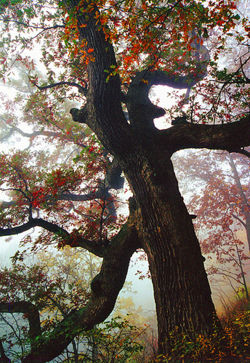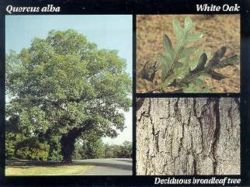White oak
| White oak |
|---|

|
| Scientific Classification |
|
| Binomial Name |
|
Quercus alba |
The White Oak (Quercus alba) is a species of oak in the white oak group Quercus sect. It is native to eastern North America, also from southern Quebec west to eastern Minnesota, and south to northern Florida and eastern Texas. The White Oak Tree can grow to be quite a large tree, rising up to 100 feet tall and up to 4 feet in diameter. It is the most important timber tree of the White Oak group and in fact one of the most important hardwoods, with its hard, heavy, tough wood used as lumber for beams, railroad ties, flooring, barrels, furniture, and many other uses.[1]
Anatomy
The White Oak tree is one of the largest trees in the forest of the eastern United States. The biggest White Oak recorded today is one found in Ohio that is 84 feet tall. The bark on this pretty tree is a light ash-gray color, and is often fissured into scaly plates. The White Oak grows best in deep well-drained upland soils. This tree is used for a lot of the things we use today such as furniture and hardwood flooring. Native American Indians once made flour from its acorns. [2] White oak generally has the reputation of being a slow-growing tree. Although white oak was once a component of mixed and uneven-aged stands, most of the white oaks today are in pure to mixed second growth stands of sprout origin.
Reproduction
The White oak bloomes in the spring when the leaves appear. This may happen any where from late March to late May depending upon latitude. Flowers of both sexes will appear on the same tree. The yellowish staminate flowers appear first. The reddish pistillate flowers will appear in about 5 to 10 days later, either singly or in pairs on short stalks.
The White oak can produce seeds efficiently, but the tree will only have a good acorn crop about every 4 to 10 years. Sometimes several years may pass without a crop. Acorn yields range from 0 to 500,000 acorns per area/acre (202,000/acre) (7,22,28).
The seeds germinate in the fall soon after dropping. For the Germination process to occur, the moisture of the acorns must not fall below 30 to 50 percent. [3]
Ecology
The White oak grows in most of the Eastern United States. They are found in southwestern Maine and extreme southern Quebec, west to southern Ontario, central Michigan, to southeastern Minnesota; south to western Iowa, eastern Kansas, Oklahoma, and Texas; east to northern Florida and Georgia.
The White oak grows in a wide range of soils and sites. It is found on podzols, gray-brown podzolic soils, brown podzolic soils, red and yellow podzolic soils, lithosols, planasols, and alluviums.
The White oak grows in connection with many other trees. The more important of which are other upland oaks (Quercus spp.), hickories (Carya spp.), and yellowpoplar (Liriodendron tulipifera).
One of the problems with this tree is that there are insects that like to attack it and damage the inside. One of the insects that does this is the wood borers, which causes wood defects. [4]
Special Uses Acorns are loved by many animals but they are an inconsistent source of wildlife food. There are over 180 different types of animals that use the oak acorns as food.
 Browse |
Related References

